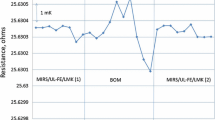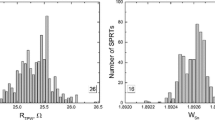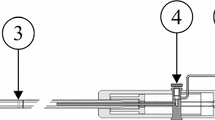Abstract
Platinum resistance thermometers (PRTs) are capable of providing reliable measurements at the millikelvin level, and are widely used in both industry and research applications. However, the intrinsic thermal noise associated with their resistance requires the use of a measurement current of typically around a milliampere to determine their resistance. Unfortunately, this same current also dissipates heat into the thermometer element, causing the well-known “self-heating” effect of typically a few millikelvins. Performing measurements in terms of the ratio to the resistance at the ice point provides some level of cancelation of this error around this temperature: If the thermal resistance between the sensor and environment were constant, this cancelation would work over a much wider temperature range. However, there is little evidence on the effectiveness of this strategy in practice. This paper reports on an extensive set of systematic measurements of the self-heating of six standard platinum resistance thermometers (SPRTs) and six industrial platinum resistance thermometers (IPRTs) of different designs, as a function of temperature, over the range from \(-190~^{\circ }\mathrm{C}\) to \(420\,^{\circ }\mathrm{C}\), in a range of intercomparison baths and blocks. The measurements show that PRT self-heating varies from being almost constant with temperature to being nearly proportional to temperature. The assumption of a roughly temperature-independent thermal resistance is thus not justified in general. The results allow estimation of appropriate uncertainty terms for SPRT and IPRT self-heating for the two scenarios of “working in \(R\)” and “working in \(W\).”





Similar content being viewed by others
References
Bureau International des Poids et Mesures (BIPM), Supplementary Information for the International Temperature scale of 1990 (BIPM, Sèvres Cedex, 1997), pp. 95–96
Bureau International des Poids et Mesures (BIPM), Techniques for Approximating the International Temperature scale of 1990 (BIPM, Sèvres Cedex, 1997), pp. 129–132.
H. Rosemay Taylor, H.A. Navarro, J. Phys. E 16, 916 (1983)
V. Batagelj, J. Bojkovski, J. Drnovsek, Meas. Sci. Technol. 14, 2151 (2003)
V. Batagelj, J. Bojkovski, J. Drnovsek, I. Pusnik, in Temperature: Its Measurement and Control in Science and Industry, vol. 7, ed. by D.C. Ripple (AIP, New York, 2003), pp. 315–320
H. Chodhury, M. Ballico, “Literature Review of Heat-Transfer Modelling in Fixed Point Cells,” in Proceedings of AHMTC Conference (Perth, Australia, 2005)
C.M. Sutton, Meas. Sci. Technol. 5, 896 (1994)
R.K. Chohan, F. Abdullah, L. Finkelstein, Trans. Inst. Meas. Control 7, 151 (1985)
H. Sakurai, L.M. Besley, Res. Sci. Instrum. 56, 1232 (1985)
L. Peng, L.M. Besley, Meas. Sci. Technol. 4, 1357 (1993)
J.V. Pearce, R.L. Rusby, P.M. Harris, L. Wright, Metrologia 50, 345 (2013)
R.I. Veltcheva, J.V. Pearce, R. daSilva, G. Machin, R.L. Rusby, in Proceedings of Ninth International Temperature Symposium, Los Angeles, Temperature: Its Measurement and Control in Science and Industry, vol. 8, ed. by C.W. Meyer, A.I.P. Proceedings 1552 (AIP, Melville, NY, 2013), pp. 433–438
Thermophysical Properties of Matter, TPRC Data Series, vol. 2, ed. by Y.S. Touloukian (IFI/Plenum, New York, 1970)
M. Ballico, Int. J. Thermophys. 32, 2360 (2011)
Acknowledgments
The authors are grateful for the assistance with the measurements given by Mr. Angus Fraser.
Author information
Authors and Affiliations
Corresponding author
Rights and permissions
About this article
Cite this article
Ballico, M.J., Sukkar, D. Temperature Dependence of IPRT and SPRT Self-Heating: Does Working with \({{\varvec{W}}}\) Really Help?. Int J Thermophys 35, 1067–1076 (2014). https://doi.org/10.1007/s10765-014-1668-3
Received:
Accepted:
Published:
Issue Date:
DOI: https://doi.org/10.1007/s10765-014-1668-3




